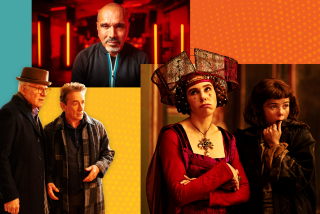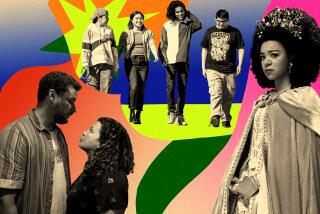âHatfields & McCoysâ is a History-changing success
âHatfields & McCoys,â the record-breaking miniseries that aired on the History channel earlier this week, came out guns blazing in more ways than one.
Its Memorial Day debut drew 13.9 million viewers, a new high for an entertainment show on ad-supported cable TV. In addition to averaging 13.8 million viewers across its three-night run, the miniseriesâ numbers actually increased on its final night to 14.3 million viewers, nearly unheard of for a multi-episode program in recent years.
âWe felt like if we had two really kick-ass nights, a third would work because people would want to see how it ended,â said Nancy Dubuc, Historyâs president and general manager. âThatâs how it grew.â
The program, a decades-long passion project for executive producer Leslie Greif, starred Kevin Costner as Devil Anse Hatfield and Bill Paxton as Randall McCoy, patriarchs of the brutal Appalachian families that started battling just after the Civil War.
The story covers the origins of the legendary feud, which are still hazy to this day, and the bloody fallout that included kidnappings, fire bombings and murders. It was Historyâs first foray into scripted programming after an aborted attempt at the genre with the controversial miniseries âThe Kennedys.â
Media watchers, often using the term âperfect storm,â attributed the success to a potent combination of star quality, good timing, strong production values, right network and muscular marketing.
âIt looked like a feature film and everything about it screamed âevent programming,ââ said Gary Lico, chief executive of CableU.tv, a cable network research firm. âThere hasnât been anything like this anywhere on TV for a while.â
Dubuc, a close-to-the-vest executive whoâs not known for showboating, acknowledged popping some Champagne at the networkâs headquarters this week as the extent of the ratings triumph sank in.
âHatfields & McCoysâ was groundbreaking for History for a number of reasons. It put the networkâs stamp on scripted programming, laying the foundation for the next show, âThe Vikings,â and proved that a beginning-of-summer holiday weekend can bring in massive crowds.
It also drew in significantly more women and younger, advertiser-coveted 18-49-year-old viewers than the channel norm. The series averaged 13.8 million viewers over its three-night run, with 6 million adults 25-54 years old and 4.9 million 18-49-year-olds, according to Nielsen.
The gender split of the audience was another milestone: 55% male, 45% female. Historyâs crowd is usually closer to 70% men, Dubuc said. The networkâs heavy slate of reality programming, which includes shows like âPawn Stars,â âSwamp Peopleâ and âIce Road Truckers,â typically appeals more to men.
Though the miniseries was aimed squarely at Historyâs core male fans, its family themes resonated with women.
âItâs a gruesome story and itâs easy on the surface to judge it as a violent western,â Dubuc said. âBut it has these very emotional threads about love and protection of family, losing your children, which are very relatable.â
Demographic breakdowns have yet to come for regions of the country, but some TV analysts think it may have scored as well in big cities as in the South or the heartland, which tend to be drawn more toward conventional storytelling like westerns.
âIt doesnât matter where you live or what ethnic background youâre from,â said Shari Anne Brill, TV research analyst. âWe all have crazy kinfolk.â
Even the timing of the miniseries, which some people in the industry questioned, turned out to be spot-on. History executives never doubted that the holiday weekend was a good platform, having premiered the hit docudrama âGettysburgâ the year prior.
Viewing levels are traditionally strong on that night, Dubuc said, and networks air mostly repeats after May sweeps. Major sporting events like the Indianapolis 500 are finished by Monday night, and competition for male viewers, at least in original programming, is weak, she said.
The run-up to Memorial Day, however, is rife with opportunity to promote an event movie to men through Stanley Cup playoffs, NBA games and other nationally televised sports. History did just that, after having spent nearly six months on its own air teasing the miniseries for its core viewers.
The marketing campaign used stark, gritty images of Costner and Paxton with the tagline, âNever forgive. Never forget.â It included stunts like wrapping New York City subway cars and sponsoring the HBOFloyd Mayweather Jr.-Miguel Cotto pay-per-view fight. TV ads used a memorable vintage-sounding song from roots rock band the Silent Comedy.
âMarketing has become so important because of the fragmented TV audience,â said David Scardino, entertainment specialist with Santa Monica ad agency RPA. âThese promotions said youâd be rewarded if you watched, and then the show made good on that.â
Since success begets imitators, âHatfields & McCoysâ may mean a further rush into westerns, a genre thatâs already started to have a renaissance, and the mostly abandoned miniseries format.
As for âHatfields & McCoys,â Dubuc said itâs too early to tell if the network will revisit the relatives from Kentucky and West Virginia. Sheâs disinclined, saying she âdoesnât want to be my own worst enemyâ by milking the hit.
Meantime, thereâs a quick turnaround on the DVD, which launches July 31.
More to Read
The biggest entertainment stories
Get our big stories about Hollywood, film, television, music, arts, culture and more right in your inbox as soon as they publish.
You may occasionally receive promotional content from the Los Angeles Times.










